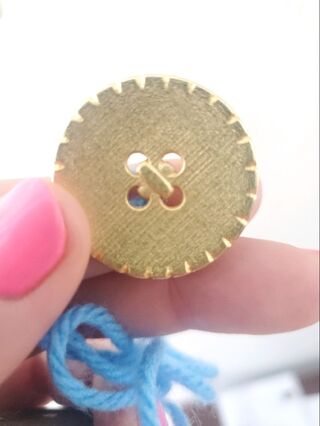Relationships
Talk Tokens: A Key to Tough Conversations
How a little button on a blue string changed conversations with my son.
Posted May 23, 2022 Reviewed by Jessica Schrader
Key points
- It can be difficult to find the right words or the right time to start a conversation about a challenging topic.
- A talk token can help people begin tough conversations by signaling to others that such a conversation is needed.
- A talk token can be a physical object or even a code word, as long as everyone in the relationship understands the special meaning it carries.

Just because you really want to tell someone something doesn’t mean it’s easy to start the conversation. In fact, sometimes the most important things are the hardest to say.
My son and I created a talk token to overcome this challenge.
It’s not fancy; just a brass-colored button on a bit of light-blue yarn. We keep it by the front door, hanging next to the keys. Unless, that is, one of us is having a hard time bringing up a challenging topic.
In those instances, the person who needs to get something off their chest drops the talk token on the table. Or hangs it on a doorknob. Or wraps it around the tube of toothpaste.
The talk token helps us communicate when words don’t quite seem right or available. It says, "Hey, I need to tell you something, but I'm having a tough time starting the conversation."
When the talk token makes an appearance, the other person stops what they’re doing. The cellphone gets tucked away. They focus in. Then, the receiver waits with patience and receptivity for the talk to begin.
We instituted the talk token after my son knew he had wanted to tell me about a friend's talk of self-harm. The friend’s mom had reached out to me to alert me to a text thread where the disclosure had happened. When I asked my son about it the next morning, tears came to his eyes. He said, “I wanted to tell you, but I wasn’t sure how.”
I get it. It can be incredibly difficult to find the right words to say and the right time to say them.
I knew then that we needed to lower the activation barrier. We needed to make it a bit easier to say whatever needs to be said, whether it be a scary thing like the situation above or a happy thing like “I’m crushing on someone at school.”
Other relationships and other signals
Those hard-to-start conversations don’t just happen between parents and kids, of course. They kick up between life partners, friends, and colleagues. Any relationship based on care and responsiveness could potentially benefit from a signal that helps orient others to our needs.
Sometimes, as mentioned above, that need is for a conversation. I heard of a married couple, for example, that uses a lovely gift they had received as a wedding present as their talk token. The fact that their totem is a wedding gift reminds them of those “through thick and thin” vows they made to each other on their wedding day, priming the constructive frame of mind these conversations warrant.
Other times, the need might be urgent assistance or social support. For example, when my friend’s kids were teenagers, they knew they could text “mom” to their parents anytime they needed help getting out of a tricky social situation, such as a party that was getting out of hand. The parents knew to call right away and say, “I need you home immediately. Where are you? I need to pick you up now.”
As another example, a social worker I know is part of a friend group that holds a wonderful agreement: If any one of them is having one of those “I don’t know if I’m going to make it through this” days or weeks or months, they simply write “Puppy Patrol” in their shared text thread. The friends immediately circle the proverbial wagons. Words of encouragement pop up on screen. The fancy coffee drink with extra whip gets delivered. A calendar invite for an evening walk arrives.
In these examples, a code word serves as the token.
Talk token tips
Really, there’s no one way to bring talk token magic to your relationships. If you’d like to give it a try, here are eight tips to keep in mind:
- The people in the relationship must share an interest in trying a talk token. This isn’t the sort of thing one can impose on others.
- The people in the relationship will need to agree that this thing now has special meaning.
- Decide with others in the relationship what the token will be, as well as any guidelines about how it will be used.
- Keep your token in a visible place so everyone has a regular reminder that it is available, should they wish to use it.
- Encourage each person to choose for themselves if and when they use the talk token. It exists in the space as an invitation, not as a requirement.
- Try it out with some low-stakes disclosures early on to help normalize the token’s presence and to model its use. This is especially important if kids are in the mix so they can see what the talk token looks like in action.
- If you’re ever presented with the token, simply receive the gift of the speaker’s trusting disclosure. Resist the urge to problem-solve, unless asked to do so. Ask what would be helpful, rather than assuming what the other person needs.
- In discussion with the others involved, adapt these ideas to make them your own.
A key to important conversations and treasured connection
The more practice my son and I get initiating the tough conversations, the easier it has become to do so. The topics, of course, will continue to shift as he moves through his teen years and into adulthood. My hope is that the disclosures we are practicing now will become habits that he will carry with him into adulthood. Perhaps we won’t use the talk token forever. Or maybe we will.
For now, we will keep it right next to the keys. It does, after all, serve as a key, keeping the doorway open to important conversations and treasured connections.




